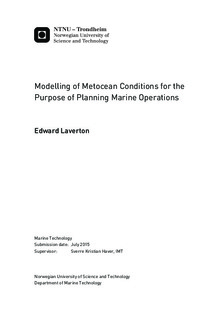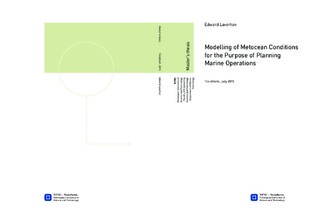| dc.description.abstract | The sea conditions of two areas, Haltenbanken and the Barents Sea, have been established in this project. Furthermore, a few cases of marine operations have been evaluated, among other topics.
The fist part establishes the sea conditions by creating a so-called Metocean Design Basis. This is a basis for determining the feasibility of e.g. a marine operation. The report focuses on sea states in terms of waves and the duration of good and bad weather windows. Current and wind is neglected. Sea states, in terms of $H_s$ and $T_p$, are presented by scatter diagrams, where tendencies of the sea environment can be observed. It is also described by mathematical models, which have been established through different techniques. The subject of probability and statistics plays a central part in establishing such a report. Extreme sea states have been obtained by using the same mathematical models along with a contour plot. The duration of good and bad weather windows have been established through simple considerations and mathematical distributions. Results show that sea conditions are more severe at Haltenbanken than in the Barents Sea.
The Metocean report constitutes a basis for investigation of marine operations, which is presented in the second part. There are two cases in this part, and the first case investigates limiting conditions in terms of the heave motion of a drill ship. Results are shown in Figure \ref{fig:summary1}, which illustrates the acceptable sea states together with relevant severe sea states. The empty pocket in-between the contour plot and the acceptable values illustrates critical sea states. This have been achieved by establishing the response spectrum, a method which assumes a linear relationship between the waves and the response of the vessel, an assumption which is probably valid for the heave response.
The feasibility of marine operations have been considered by employing the distribution for the duration of the longest good weather windows. Additionally, the feasibility of marine operations have been looked at by simulation. Two different methods were considered, and the one which employs data directly seems to yield the most accurate results. The other method, which employs the distribution of duration of good and bad weather windows, seems to have a potential, and could be improved in further work. Its strength lies in the ability to employ Monte Carlo simulation, while its weakness lies in its inflexibility of handling different thresholds.
The second case is a study of the roll motion of a vessel. The purpose of the case is to investigate what kind of effect the roll motion of the ship, due to swell sea, has on the usability of good weather windows. Results are given in Figure \ref{fig:summary2}. These show a drastic reduction in the average duration of good weather windows due roll motion caused by swell sea. Reductions seem too significant, and this is most likely because the damping of the roll motion is not sufficiently incorporated in the analysis. Although the results are probably not sufficiently accurate, they show that the swell sea has a significant effect on weather conditions which otherwise are considered as more than suitable. This could possibly confirm that the swell sea should be given more attention during the process of planning of a marine operation. | |

